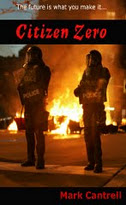Coming Home To Roost
AT last, a public-private initiative has come forward to provide the elusive answer to the country’s housing crisis. The Archipelago Project is intended to accommodate the low paid and deprived members of our society, but it all depends on the success of the pilot scheme. Mark Cantrell visited the prototype site and asked – can Containment Facility 1.01 deliver the Promised Land?
THE sun is still low in the sky, but the future residents of Containment Facility 1.01 have already been hard at work for hours. It’s a show of their dedication to the scheme, but also the enthusiasm it has inspired in these former housing association tenants, that they are prepared to undertake such labours.
Dressed in their orange jump-suits, they provide an eye-watering splash of colour to an otherwise drab construction site on what is a cheerless winter morning, but their back-breaking activity shows a hardiness of spirit fit for pioneers – which in a way they are.
Containment Facility 1.01 is but the beginning of a vast – critics might say utopian – vision to change the social landscape of the country. It marks the launch pad for the Archipelago Project, a far-reaching plan that aims to create a string of such satellite facilities around the country’s major towns and cities. The purpose is to forge a two-pronged strategy of both social and economic revitalisation, and finally eliminate the problems that have dogged planners and policy makers for decades.
So there’s a lot riding on a successful outcome to this pilot scheme: not just the realisation of the vision, or the homes for those most in need, but also hard cash provided by funding bodies and – much more crucially – private sector investors. Naturally, they will want to see results where it matters most.
Much of the techniques brought to bear on the project are intended to maximise cost-efficiency gains and value for money, but this is about more than just bean-counting – those socio-economic aspects are not mere window dressing, but an integral part of the efficiency drives.
One of these cost-efficiency measures is to involve the future residents in the actual construction of the site. They were decanted out of their old estate in one fell swoop and put up in a ‘tent city’ within the site’s perimeter. That released the former estate for sale to development partners, thereby releasing capital, and also provided an on-site labour force that reduces development costs. The use of heavy – and costly – machinery is avoided wherever possible, making the fullest use of human muscle power to give the residents a physical stake in their new community.
This ‘self build’ initiative is one of many important innovations that have made the Archipelago Project such an exciting venture for its stakeholders. It is intended to give the residents more than just a sense of involvement in their future, but also a sense of ownership. When it is completed, they’ll be able to take pride in knowing that their own sweat helped make it real.
“The work is important to the process of building a sustainable community, both to foster a sense of having a place and being in that place,” said Tony Lubyanka, Chief Executive for Drezhinsky Square Housing Trust (DSHT). “That way we forge the strong moral fibre our modern economy needs to sustain shareholder value. By working on their own barracks, they will gain a sense of camaraderie and community needed to help foster social cohesion. As well as providing a sense of ownership it will also teach these people the value of hard work.”
The Government has expressed great interest in the outcome of the scheme, and not just in the form of the Home Office’s direct – though ‘back seat’ – involvement. A number of Government departments are watching the scheme closely. A spokesman for the Secretary of State for Municipal Morality, Community Cohesion & Social Control said: “Containment Facility 1.01 is a wonderful scheme and we wish it well. We are excited by its potential and are especially pleased to note that it shows how the principles of philanthropy are alive and well in the private sector. This isn’t about base money-grubbing but about providing for the neediest in our society. As a Brand New Labour™ Government we are proud to work with private sector partners in the fulfilment of our party’s founding principles. The working class can rest assured we will continue to fight the cause of poverty.”
Drezhinsky Square, as the actual hands on development body, is at the sharp end of making Containment Facility 1.01 a reality. It was established as an executive agency of the wider Consortium responsible for the Archipelago Project. The members include the Home Office, Cheka Security plc, and Guantanamo Developments inc., along with a variety of contractors and specialist advisers.
The Consortium members put significant capital into the project, but also received massive contributions from regional development grants and Government funding, as well as investment from private sources looking to house aspects of their business operations close to the site. After a quick whip round among staff, the Tony Blair Foundation for Social Justice also provided a special ‘Noblesse Oblige Award’ worth a whole £3.42 and, as it turned out, a five pfennig piece. Guantanamo donated the residents’ orange jump-suits as an added show of the company’s faith in the scheme’s potential.
Lubyanka was appointed for his extensive experience in handling tough scenarios and making projects happen. His no-nonsense approach stems from a rather colourful and unusual background which further testifies the ‘beyond the box’ thinking that is being applied to the Archipelago Project.
As a former United States Marine, then ‘specialist contractor’, he has – as he put it – gained a wealth of experience “pacifying problem communities” in areas as diverse as ‘Git’mo’, in Cuba; Afghanistan; the former Republic of Iraq; and other parts of the Middle East. His manner is brusque and efficient, and every bit the military specialist even in civilian life. It’s the kind of experience fellow executives in the Consortium feel is needed for the Archipelago ahead.
He added: “One thing my experience has taught me – success demands discipline, planning, teamwork, leadership, a clear vision and corrupt officials. Get that mix right and the ability to kill a man with two fingers and a watchstrap becomes a mere perk of the job.”
According to the literature, Containment Facility 1.01 is a ‘ground-breaking mixed use residential/industrial scheme’. When it is complete, the three sub-compounds – one each for men, women and children – will house around 30,000 people. There will also be a smaller test-facility for housing asylum seekers. Later Archipelago developments will accommodate at least twice that number. The compounds will be located adjacent to an industrial park constructed as part of the wider complex. The aim is to offer light industrial, warehousing, back office functions and other employment tasks suitable to a low- to semi-skilled labour base. So not only does the Archipelago Project aim to deal a blow to the nation’s housing crisis, it also fosters a work-based initiative that is intended to create a boost to the local and regional economies nearby each facility.
As Lubyanka said: “The Facility’s secondary role is about restoring some much needed economic viability to what has hitherto been so much redundant livestock. Instead of being a burden on society, they’ll have a chance to make a positive contribution to life in the 21st Century. That’s got to be good for us all.”
In addition to tackling unemployment and deprivation, the scheme will also provide key worker accommodation so that essential services can overcome the problem of labour depletion, due to high local housing costs. Along with other higher skilled workers in other economic sectors, who also find they have been priced out of the market, they will gain both a home and employment opportunities.
This is where the higher tech end of the scheme will come into play. Security is considered a very big deal indeed at Containment Facility 1.01, so for their own security and peace of mind, every resident has been implanted – free of charge – with a GPS locator. These devices, no bigger than a grain of rice, are implanted at the base of the skull. They monitor the owner’s whereabouts and ensure they need never get lost: an important security and safety consideration. This will enable key workers and others granted right of passage beyond the perimeter to find their way easily to the location of employment.
“Security and peace of mind is always an important consideration in any development like this,” Lubyanka added. “Those transponders will help us identify and keep track of work unit members who are permitted beyond the perimeter. As well as providing the GPS capability, the inserts also integrate fully with local city and regional security grids. We know where they are 24/7 – and so will our neighbours.”
And, of course, in those bright orange jump-suits they’ll tend to be highly visible.
Such security measures are important, but these matters start very much at home. That’s why the construction of a rugged perimeter was deemed paramount and so work on the security fence began at once, before the newly-arrived residents even pitched their tents. Resident teams, under the guidance of skilled contractors, have been working hard on this aspect of the site. Only a few posts remain to be erected and connected with a stout web of military-grade razor wire. Once it is complete, the fence will be hooked up to its own dedicated power supply. Work will then commence on the remaining security components.
No expense has been spared in this regard, courtesy of Home Office funding, and the full package will feature CCTV, infra-red motion detectors, ground-based localised tremor-sensors, pheromone-signature ‘sniffer’ sensors, face recognition, DNA profile scans and, of course the embedded GPS locators. So the future residents can sleep sound in their beds knowing that their community is safe.
While work on the fence is nearing completion, the rest of Containment Facility 1.01 currently doesn’t look like much. For such a ground-breaking scheme, it looks more like an impromptu refugee camp, but the residents are working hard with pick and shovel to prepare the pits for foundations and the trenches for the utilities. It speaks volumes about the extent of their dedication that they are prepared to slum it under canvass through this cold winter.
Once this work is complete, then they will begin work on assembling the actual accommodation blocks. The plans feature the latest in modern methods of construction. Each accommodation block is being manufactured in pods and panels off-site and will subsequently be delivered in kit form. The design makes them ideal for assembly by low-skilled labour, which means the residents shouldn’t have many problems. Once complete each communal barrack will house up to 100 people. The residents will surely be glad to sleep under a roof rather than canvas, but for now there’s plenty of work to keep them busy – and warm – until the site is ready for the barracks.
Meanwhile, DSHT is working on redeveloping its retained portion of the estate from where Containment Facility 1.01’s population was taken. In partnership with land-sale recipients, the Consortium is developing the Stepford Lives Scheme. This will be a luxury mixed use community, fully integrated with parkland and water features. As well as luxury apartments and family housing, the development will see shops, offices, restaurants and the creation of a complete neighbourhood tailored to the needs of the modern consumer. Once complete, it will be a far cry from the neglected and run down housing association estate it once was.
The Consortium has high hopes that this twin regeneration approach will achieve the Grail of solving the housing crisis, with all its attendant social problems such as crime.
“It’s the ideal solution,” says Lubyanka. “Statistics show that most offending is carried out by the offensive – the poor the deprived and the low paid. Our approach here protects the community and promotes social peace of mind. We will take the dregs of your society, the discarded, the social trash and turn them into productive economic units. And we guarantee a low-cost per unit maintenance charge. It makes sense – economically and socially. We have a winning solution here at Containment Facility 1.01.”
Of course, with a scheme as far reaching as this, it is impossible to please everyone. Some of the residents expressed some discontent, but the subdued manner in which they spoke provided clear evidence that such dissenting views are very much the minority.
As one sullen soul said: “They took my house. I owned that house. It was mine. They stole it and dumped me in this gulag! That’s not right. I was a trade unionist for thirty years and I tell you this is wrong!”
In such a large population, such instances of anti-social behaviour are perhaps inevitable, but it’s something they take a dim view of at Containment Facility 1.01, as this hapless troublemaker discovered. Thanks to Cheka Security, there are stern measures on hand for transgressors of the social peace.
Joe Steelman, the site’s Public Order Manager smacked his discharged electric baton into his gloved hand for effect when he said: “They give us any lip, we give them a 50, 000 volt rim job. They don’t give us no bother after that.”
So both the residents and the neighbours can rest assured that anti-social behaviour and instances of poor public morality will not be tolerated. That’s probably why the few nay-sayers are so subdued in their bile; they know they are on to a losing streak and most of the residents are behind the scheme.
This was made clear by Alan ‘Salsa’ Nitzin, chair of the residents’ liaison committee. A nervous man, clearly not used to public speaking, he read from a prepared statement: “We are very excited by this exciting and forward looking innovative new development to house the poor and deprived members of our free communities. [Smile.] As the future residents of this very exciting Containment Facility 1.01 we are really very pleased and excited to have been chosen to take part in this initiative that has so much to offer our community and our country. [Grin.] We are proud to work with Drezhinsky Square Housing Trust and its partners. This is an exciting time for us all. [Tug forelock.] We will be very happy here.”
And who can argue with that?
Containment Facility 1.01 – and beyond it the Archipelago – won’t be everyone’s idea of an ideal home, with many doubtless preferring a more traditional form of tenure. For the vast majority struggling under the elements of modern living, however, the Project offers a once in a lifetime opportunity to find themselves living in a secure environment. It is, as the Consortium says in its glossy literature, the final solution to a swathe of social problems – for the benefit of every stakeholder.
“It’s about the future of our communities and our society – and our whole goddammed economy,” Lubyanka added. “These people here, they’ve got to bite the bullet for everyone’s sake. What kind of world do we leave our kids? How safe is it going to be for them? For our own peace of mind, for the freedom and prosperity we enjoy, we have to tackle this crucial issue fast. There’s some tough choices to make and you’re either with us or against us. That’s what Containment Facility 1.01 and the Archipelago Project is all about: protecting and preserving our way of life!”
So, the future’s bright, then? Time – and Containment Facility 1.01 – will tell.
* * *
NEXT MONTH: Get me outa here – I’m a journalist. An in-depth look at Fourth Estates' latest project to convert a historic mediaeval correctional establishment into accommodation designed exclusively with media professionals in mind.
* * *
LEGAL DISCLAIMER: This article has been produced and independently verified as fit for purpose under the provisions of Home Office anti-terrorism guidelines ‘Integrity & Honesty in Media®’. While independent scrutinisers take every effort to ensure it matches current legislative requirements of suitable truth, errors can slip through. Therefore, if there is something about this article that offends, or you know to be otherwise inappropriate, then contact your local police station or the Home Office Direct™ contact centre and report the author/publication. Lines are open 24/7 and are maintained in strictest confidence. Thank you for your due diligence and co-operation in these matters of national security.
ENDS
Mark Cantrell,
Stoke-on-Trent,
10 September 2006
Copyright (C) September 2006. All Rights Reserved.
Category: FICTION



























0 comments:
Post a Comment